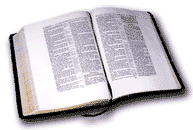"Yahweh Establishes"
Jeremiah the Hebrew
prophet, watched the nation of Judah decline until
it was carried away into captivity by the
Babylonians. He watched and wept as the Temple was
destroyed.
One of the difficulties
in interpreting Jeremiah is due to chronological
inconsistency. It is not presented in chronological
order. Jeremiah compiled his prophecies in stages;
he often places prophecies together that are dated
years apart. This may be attributed to the times in
which he prophesied which were filled with stress,
upheaval and despondency. Those were chaotic days in
Judah.
AUTHOR:
Jeremiah, the weeping prophet (1:1; 9:1; 20:9) is
the central personality in the book and is
considered by most conservative scholars as the
author. He is one of the greatest prophets of
Israel. Notations at the beginning of chapters,
scattered throughout the book, indicate the
authorship of Jeremiah. He is a major writing
prophet in the Old Testament who prophesied during
the reigns of the last five kings (Josiah, Jehoahaz,
Jehoiakim, Jehoiachin, and Zedekiah) at the time of
the decline and fall of the southern kingdom of
Judah. He was the son of Hilkiah, a priest, and grew
up in the little town of Anathoth, about three miles
northeast of Jerusalem (Jer. 1:1-2). He is mentioned
by name in 2 Chronicles 35:25; 36:12, 21, 22; Ezra
1:1; Daniel 9:2; Matthew 2:17; 16:14; 27:9. He was
never married (Jer. 16:1-4).
NAME: There is
uncertainty among Hebrew scholars concerning the
meaning of the name "Jeremiah." The most literal
translation is "Yahweh loosens (the womb)." Some
suggest it means "Yahweh exalts," "Yahweh
establishes," "Yahweh sets free." J. W. Watts
suggests, "JHVH founds," or "JHVH hurls" with the
sense of laying a foundation is based on 1:10, 12,
19. Yahweh establishes, appoints or sends.
DATE:
Jeremiah began his ministry about seventy years
after Isaiah, i.e., 626-585 B.C. God called him to
the prophetic ministry during the 13th year of
Josiah's reign (Jer. 1:2-10; 23:5) in 626 B.C. His
ministry lasted for about fifty years because even
after the fall in 586 B.C., he continued to prophesy
in Egypt. The prophet’s writing ministry began in
the fourth year of Jehoiakim’s reign in 605 B.C.
(36:1, 2), and was completed sometime after the fall
of Jerusalem in 586 B.C. Jeremiah was a contemporary
of Zephaniah, Habakkuk, Daniel, and Ezekiel.
PURPOSE: The prominent
theme is the coming captivity of Judah. God judges
sin and rewards righteousness. He confronted
hypocritical priests, false prophets and corrupt
kings. You reap what you sow, regardless of who you
are. The book begins with the call of Jeremiah and
ends with the captivity of Judah. It is a book
depicting the coming judgment of God on His
rebellious people. Moreover, part of his purpose
focuses on the most distant future when the old
covenant will be replaced by the new covenant (Jer.
31:31-37).
KEY VERSE:
3:14a
KEY WORD:
return
METHOD:
Jeremiah is a colorful prophet who spoke in Temple
courts, royal palace, city gates, feast and fast
days to anyone who would stop to listen to him. He
used lots of symbolism such as a long journey,
potter's wheel, breaking a pitcher into fragments,
purchase of a field in the time of siege, etc.
Jeremiah dictated his messages to a scribe, Baruch
over a period of several years (36:1-4). Baruch
delivered the messages to King Jehoiakim since
Jeremiah was banned from the royal court. The book
is not written in chronological order and is
difficult to outline. Perhaps the best outlines are
based on the kings with whom Jeremiah is associated.
STYLE:
Jeremiah was a master at using figures of speech,
metaphors, and symbolic behavior to communicate his
message. His style is simple, sometimes labored and
tedious, powerful with evidence of a deep spiritual
passion. He usually starts with a simple story or
illustration and follows with applications. It
contains symbolism, illustrations, biography,
history and prophecy. However, it is one of the most
difficult books to understand because it does not
have a chronological arrangement. Because of hostile
opposition from his own countrymen he was forced to
re-write his book after it was destroyed (Jer.
36:22-23, 32). He was, by nature, gentle and tender
in his feelings, and sympathetic, but a decided
contrast to this is found in the hard and unmerciful
judgment which was his mission to announce. Jeremiah
was commanded to preach the judgment upon Judah. God
made him strong and firm and immovable like iron for
his mission (1:18; 15:20). This contrast between
his naturally warm personal feelings and his strict
Divine mission appears in the heart-utterances found
in his prophecies. He remained faithful to the word
of God despite the indescribable hardships.
BACKGROUND:
Jeremiah probably had the most difficult ministry in
the O.T. (Jer. 5:31) where he encountered a strange
combination of Canaanite religions, Jezebel's
Baalism, Babylonian cults, and a meaningless formal
Judaism. He helped Josiah, the last of the good
kings, in his reforms. When Nebuchadnezzar invaded
Palestine in 605 B.C., Jeremiah said it was the will
of God that Judah submit to him. When false priests
and prophets prohibited Jeremiah from appearing in
public God told him to put his prophecies in
writing. These were read in the Temple on a fast day
by his servant Baruch. King Jehoiakim destroyed the
book and ordered the arrest of Jeremiah. "But the
LORD hid him." Jeremiah wrote the prophecy again,
and later was persecuted by the military authorities
under King Zedekiah. When Nebuchadnezzar laid siege
to Jerusalem and withdrew Jeremiah prophesied that
the Babylonians would come again and burn the city.
The king accused him of being a traitor and put him
in prison.
Jerusalem fell when its
walls were breached in the fourth month of 586 B.C.
One month later, the temple was burned, along with
the palaces, houses, and other administrative
buildings. An additional 4,600 Jerusalemites were
deported to Babylon. Gedaliah was appointed governor
of Judah at Riblah. Jeremiah, who had been
imprisoned by Zedekiah, was released and sent to
serve under Gedaliah. Gedaliah was assassinated and
his supporters fled to Egypt, fearful of
Nebuchadnezzar’s revenge. Jeremiah was given a
choice of going to Babylon under protection or
remaining in Palestine. He stayed with the remnant
in Palestine until he was carried by force to Egypt
(Jer. 42:1ff; 43:8-13; Jer. 44) where he continued
his prophetic ministry (chaps. 43-44). At that time
Jeremiah must have been from 70 to 80 years old. He
probably died soon after this in Egypt. The church
Fathers report that he was stoned to death at Daphne
by the Jews. There is a rabbinical tradition that
says Jeremiah, in company with Baruch, was taken
from Egypt to Babylon by Nebuchadnezzar, and died
there. Both of these reports are not well founded,
however. He was "misunderstood by his own family,
opposed by priest and prophet, shunned by his
people, his life was a tragic experience." No wonder
we know him as the weeping prophet. However, in
Judah’s darkest hour, Jeremiah prophesied that a
remnant would return from Babylonia after their
captivity to restore their way of life and to
worship God again in the Temple (32:26–44).
CHRONOLOGY OF JEREMIAH
722 B.C. Northern Kingdom
of Israel conquered by the Assyrians
640 B.C. Josiah becomes
king of Judah
622 B.C. Josiah's reforms
(2 Kings 22, 23)
625-605 B.C.
Nabopolassar, father of Nabuchadnezzar conqueror of
Assyria reigned over Babylon
626 B.C. Call of Jeremiah
640-608 B.C. Reign of
Josiah
632 Josiah renounces the
Assyrian cult
612 B.C. Fall of Nineveh
to the Babylonians and Medes
608 B.C. Death of Josiah
at Megiddo
608 (3 months) reign of
Jehoahaz
608-597 B.C. Reign of
Jehoiakim
605 B.C. Battle of
Carchemish, defeat of Egypt by Chaldeans and Medes
and fall of Assyrian Empire
605 B.C. First siege of
Jerusalem by Nebuchadnezzar (Daniel exiled to
Babylon)
605 B.C. Death of
Nabopolassar
605-562 B.C.
Nebuchadnezzar reigned over Babylonian empire
601 B.C. Nebuchadnezzar
defeated by Necho at Egyptian border
597 B.C. Jehoiakim died
violently in Jerusalem
597 B.C. Jehoiachin
(Jeconiah or Coniah), exiled to Babylon with Ezekiel
597-586 B.C. Reign of
Zedekiah; Second siege of Jerusalem
594 B.C. Rebellion in
Babylon
592 B.C. Call of Ezekiel
588-586 B.C. Final siege
of Jerusalem
586 B.C. Fall of
Jerusalem and Judah, destruction of Solomon's
Temple, beginning of Babylonian Captivity
586 B.C. (?) Assination
of Gedaliah
585 B.C. Jeremiah taken
to Egypt
582 B.C. Last exiles
taken to Babylon y Nebuzaradan
SPECIAL THEMES:
The scope of Jeremiah's
ministry reaches beyond Judah to the Gentile nations
(chaps. 46-51). He is a "prophet to the nations"
(Jer. 1:5, 10). He saw nations rise and fall, and he
was absolutely sure that Yahweh was the power behind
those events. He refers to such places as Egypt, Uz,
Philistia, Edom, Moab, Ammon, Tyre, Sidon, Elam, and
Media, and others both named and unnamed (25:15–31;
27:2-4). He even calls Nebuchadnezzar Yahweh's
"servant" (Jer. 25:9; 27:6; 43:10).
1. Gentiles share in the
Messianic Kingdom (3:14-18; 12:15-17; 16:14-21;
48:47; 49:6).
2. The greater Son of
David will be the King of Kings (23:1-8; 30; 31;
33:14-26).
3. The New Covenant with
Israel (31:31-34; 32:36-44; Heb. 8 and 10).
4. Messiah in Jeremiah
Fountain of Living Waters
(Jer. 2:13; Jn. 4:10-14)
Great Physician (Jer.
8:22; I Pet. 2:24; Matt. 9:35)
Good Shepherd (Jer. 23:4;
31:10; Isa. 40:11; Jn. 10:11ff)
Righteous Branch (Jer.
23:4-6; 33:15-16)
David the King (Jer.
30:9; Luke 1:32-33; Rev. 5:5)
Redeemer (Jer. 50:34; 1
Pet. 1:18, 19; Heb. 9:12)
Our Righteousness (Jer.
23:6; 2 Cor. 5:21)
Jeremiah is mentioned
only in Matthew 2:17 (Jer. 31:15); 16:14; 27:9 (cf.
Jer. 32:9; Zech. 11:13). The stoning of God's
messengers in Matt. 23:37 and Heb. 11:37 also refers
to Jeremiah.
The messianic prophecies
contained in Jeremiah find their full and complete
realization in the coming of the Messiah, Jesus
Christ. He is clearly seen as the coming Shepherd
and Righteous Branch in chapter 23:1–8. He will
bring in the new covenant (31:31–34), which will
fulfill God’s covenants with Abraham (Gen. 12:1–3;
17:1–8), Moses and God's chosen people (Deut.
28–30), and David (2 Sam. 7:1–17).
Many scholars have
pointed out that Jeremiah also declares Yahweh's
message of the curse on Jehoiachin (Jeconiah,
Coniah). Yahweh decreed that no physical descendant
would succeed Jehoiachin to the throne (22:28–30).
Matthew 1:1–17 traces the genealogy of Christ
through Solomon and Jeconiah to His legal (but not
His physical) father Joseph. It is clear that no son
of Joseph could sit upon the throne of David, for he
would be under the curse of Jehoiachin. Moreover,
Luke 3:23–38 traces Christ’s lineage backward from
Mary (His physical parent) through David’s other son
Nathan (Luke 3:31), thereby avoiding the curse. The
Righteous Branch will indeed reign on the throne of
David. Jesus Christ is the only possible legitimate
legal and royal Messiah.
The centerpiece of
Jeremiah’s future age was the return from Exile.
Yahweh’s people would return after seventy years
(Jer. 25:12; 29:10) purified by the Exile.
However, Jeremiah saw farther into the future than
the Exile. God gave him a vision of a renewed
Jerusalem that would reflect God’s holiness (Jer.
31:23–25) and bear a new name, “The Lord is our
righteousness” (Jer. 33:16). The Messianic age is
distinguished by a restored Davidic Ruler, the
Righteous Branch, who will dispense equity and
justice (Jer. 23:5; 33:14–16). Both Judah and
Israel will come to Zion (Jer. 50:4–5), and the
Gentiles will benefit from the blessings of that new
day (Jer. 3:17). The new covenant will be written
on the hearts of men and women, and the law of God
will be thus internalized (Jer. 31:31–34). His
prophecy of the new covenant in Jeremiah 31:31-34
finds its fulfillment the Christ.
Title: Introduction
to Jeremiah
Series:
Introduction to Bible Books



